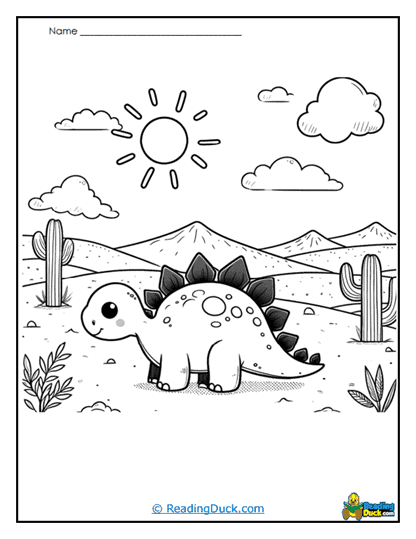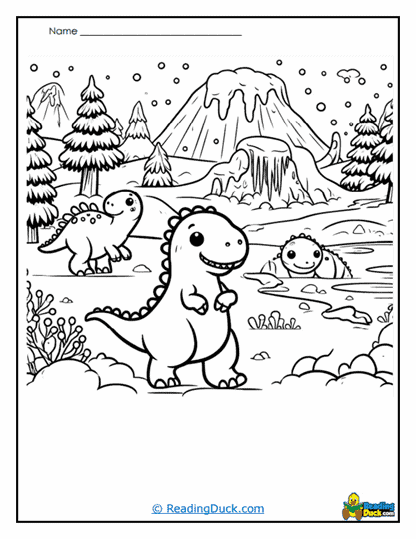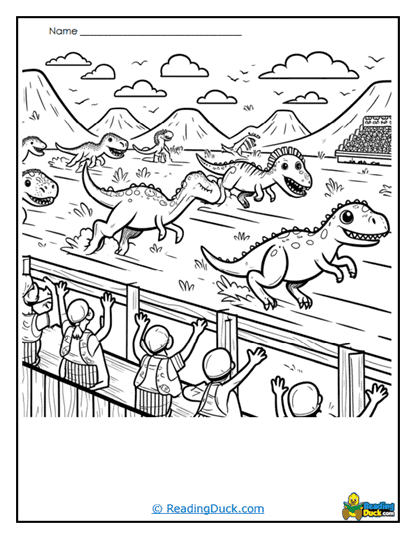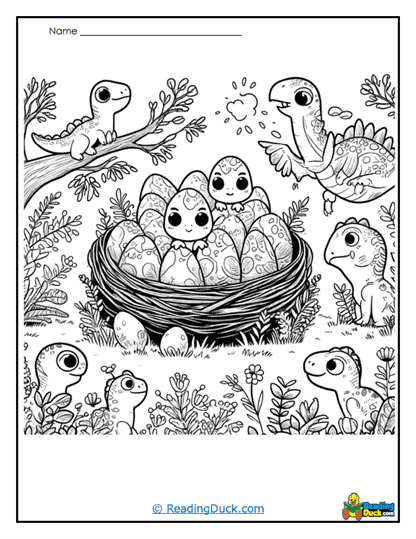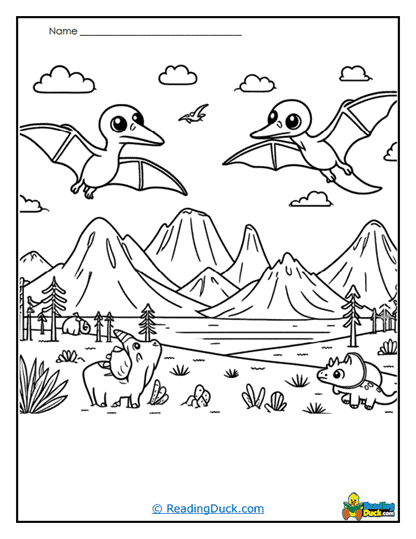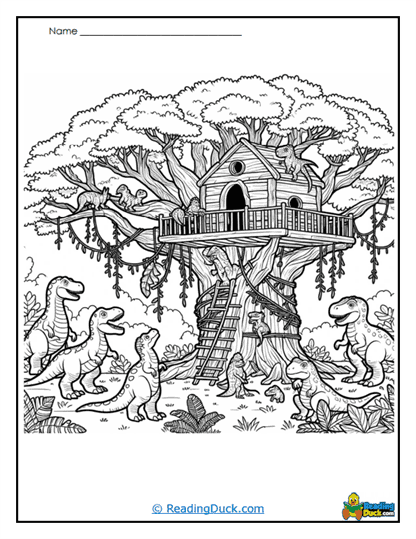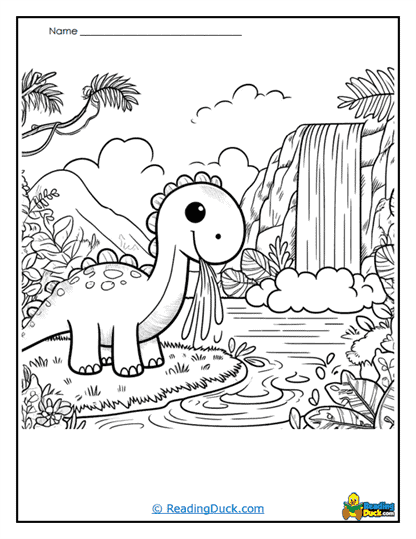Dinosaur Worksheets
About Our Dinosaur Coloring Pages
Our Dinosaur Worksheets collection is an exciting set of printable coloring pages that feature a variety of dinosaurs in unique and captivating scenes. Designed to ignite the imaginations of young learners, these worksheets are perfect for both classroom and home use. Available in PDF format, they are easy to view, download, and print, making them a convenient and versatile resource for educators and parents alike.
The Educational Value of Dinosaur-Themed Coloring Activities
Dinosaurs are a timeless favorite among children, making them an ideal subject for educational activities. The Dinosaur Worksheets provide more than just an opportunity to color; they offer a chance to engage children in learning across multiple disciplines.
- Historical Curiosity: Dinosaurs naturally spark curiosity about history and the prehistoric world. As children color, educators can introduce basic concepts of paleontology, such as what dinosaurs were, when they lived, and how we know about them today. This lays the groundwork for an early interest in science and history.
- Vocabulary Building: Each dinosaur comes with its unique name, encouraging children to expand their vocabulary and learn to pronounce and recognize new words. Teachers can use the worksheets to introduce terms like “carnivore,” “herbivore,” and “fossil,” helping to build a rich and varied vocabulary related to the prehistoric world.
- Understanding Size and Scale: Dinosaurs come in many sizes, from the towering Brachiosaurus to the small Velociraptor. Coloring these massive creatures next to smaller elements like trees or other animals helps children understand concepts of size and scale, making abstract ideas more tangible and comprehensible.
Integrating Dinosaur Worksheets into Broader Learning Themes
The fascination with dinosaurs provides an excellent opportunity to integrate these worksheets into broader thematic units or learning modules, enriching the educational experience.
- Dinosaur Habitats and Ecosystems: Use the Dinosaur Worksheets as part of a lesson on ancient ecosystems. After coloring their dinosaurs, students can create a habitat backdrop, placing their creatures in appropriate environments like lush forests, arid deserts, or volcanic landscapes. This exercise can lead to discussions about what different dinosaurs ate, how they interacted with their environment, and how their physical traits helped them survive.
- Timeline of Life: Incorporate the Dinosaur Worksheets into a unit on the timeline of life on Earth. Children can learn about the Mesozoic Era, the periods of the Triassic, Jurassic, and Cretaceous, and when different dinosaurs lived. After coloring, students can place their dinosaurs on a classroom timeline, visualizing when these incredible creatures roamed the Earth.
- Dinosaur-Themed Math Activities: Use the Dinosaur Worksheets to reinforce math concepts such as counting, sorting, and patterns. For example, children can count the number of spikes on a Stegosaurus or compare the sizes of different dinosaurs. Teachers can also create simple math problems, like “If there are three Triceratops and two T. rex, how many dinosaurs are there in total?” blending math with their love of dinosaurs.
Exploring Scientific Concepts Through Dinosaur Worksheets
The Dinosaur Worksheets offer a unique opportunity to introduce young learners to scientific concepts in an engaging and accessible way.
- Basic Paleontology: Introduce children to the basics of paleontology by discussing how scientists discover and study dinosaur fossils. Educators can create a “dig site” activity where children pretend to be paleontologists, carefully coloring in the “fossils” of dinosaurs on the worksheets and then learning about the process of uncovering and studying these ancient creatures.
- Adaptation and Survival: Each dinosaur had specific adaptations that helped it survive in its environment. Use the worksheets to discuss these adaptations, such as the long neck of a Brachiosaurus for reaching high vegetation or the sharp teeth of a T. rex for hunting. After coloring, students can present their dinosaurs to the class, explaining how their dinosaur’s features helped it thrive.
- Extinction and Change: The story of dinosaurs naturally leads to discussions about extinction and change over time. Educators can use the worksheets as a starting point to talk about what happened to the dinosaurs and why they no longer exist today. This can be expanded into a broader conversation about how life on Earth has evolved and how environments can change drastically over millions of years.
Supplementary Activities and Creative Extensions
To maximize the educational potential of the Dinosaur Worksheets, consider incorporating these supplementary activities and creative extensions into your lesson plans:
- Dinosaur Dioramas: After coloring, have students create dioramas that feature their dinosaurs in a prehistoric setting. Using shoeboxes, clay, and natural materials like rocks and leaves, they can build a 3D scene that showcases their understanding of dinosaur habitats. This hands-on project reinforces concepts of ecology and geography while allowing for creative expression.
- Dinosaur Fact Cards: Turn each colored dinosaur into a fact card. Students can research their dinosaur and write down interesting facts about its size, diet, and time period on the back of their coloring page. These cards can be used in a classroom “Dinosaur Museum” where children can share their knowledge with others, fostering a collaborative learning environment.
- Interactive Storytime: Use the Dinosaur Worksheets as a basis for an interactive storytelling session. Children can create stories about their dinosaurs—what adventures they go on, how they interact with other dinosaurs, and what challenges they face. This activity can be extended by having students act out their stories in small groups, enhancing both their creativity and social skills.
- Dinosaur Rubbings and Tracings: For a tactile learning experience, have students create rubbings or tracings of their colored dinosaurs. They can place a thin sheet of paper over the worksheet and use crayons or pencils to create a textured rubbing. This activity can lead to discussions about fossils and how paleontologists might use similar techniques to study ancient bones and imprints.
Making Learning Accessible and Engaging
Our Dinosaur Worksheets are designed to be both fun and educational, making them an excellent resource for young learners. The captivating imagery of dinosaurs helps maintain students' interest, while the format is flexible enough to be used in a variety of educational settings.
- Ease of Use: The PDF format ensures that these worksheets are readily accessible and easy to print, allowing educators and parents to integrate them into lessons or activities with minimal preparation. This makes them ideal for quick educational activities or more extensive, themed units.
- Adaptability for Various Ages: The Dinosaur Worksheets can be adapted for different age groups and learning levels. Younger children can focus on simple coloring and recognition activities, while older students can delve into more complex topics such as adaptation, extinction, and the scientific method.
- Encouragement of Independent Learning: These worksheets are perfect for independent work, allowing children to explore their interests in dinosaurs at their own pace. Whether used as part of a structured lesson, a morning activity, or free-choice time, the Dinosaur Worksheets provide a productive and engaging way for children to learn and express themselves.
Integrating Dinosaur Worksheets into Daily Routines
Educators can easily incorporate the Dinosaur Worksheets into daily routines, making them a consistent part of the learning environment:
- Morning Warm-Up: Start the day with a creative and calming activity by having students color a Dinosaur Worksheet as they settle into the classroom. This can serve as a gentle transition into the day’s lessons and help focus their attention.
- Learning Centers or Stations: Use the Dinosaur Worksheets in learning centers or stations. This allows children to engage in fine motor activities and learn about dinosaurs independently while rotating through different subjects. In a homeschool setup, these worksheets can be part of an independent study period, giving parents time to attend to other tasks or work with other children.
- End-of-Day Reflection: Use the Dinosaur Worksheets as part of an end-of-day reflection. Students can discuss what they learned about dinosaurs, share their coloring choices, and talk about what they found most interesting. This helps reinforce the day’s learning and provides a relaxing, thoughtful way to close the school day.
In conclusion, our Dinosaur Worksheets collection offers much more than just a coloring activity. They are a comprehensive educational tool that supports the development of fine motor skills, fosters creativity, and introduces young learners to important scientific concepts.
Perfect for both classroom and home use, these worksheets provide countless opportunities for children to explore their interest in dinosaurs, learn about the prehistoric world, and develop foundational skills in a fun and engaging way. Whether used in focused lessons, thematic units, or as part of daily routines, the Dinosaur Worksheets are a valuable resource for any early childhood education program.
